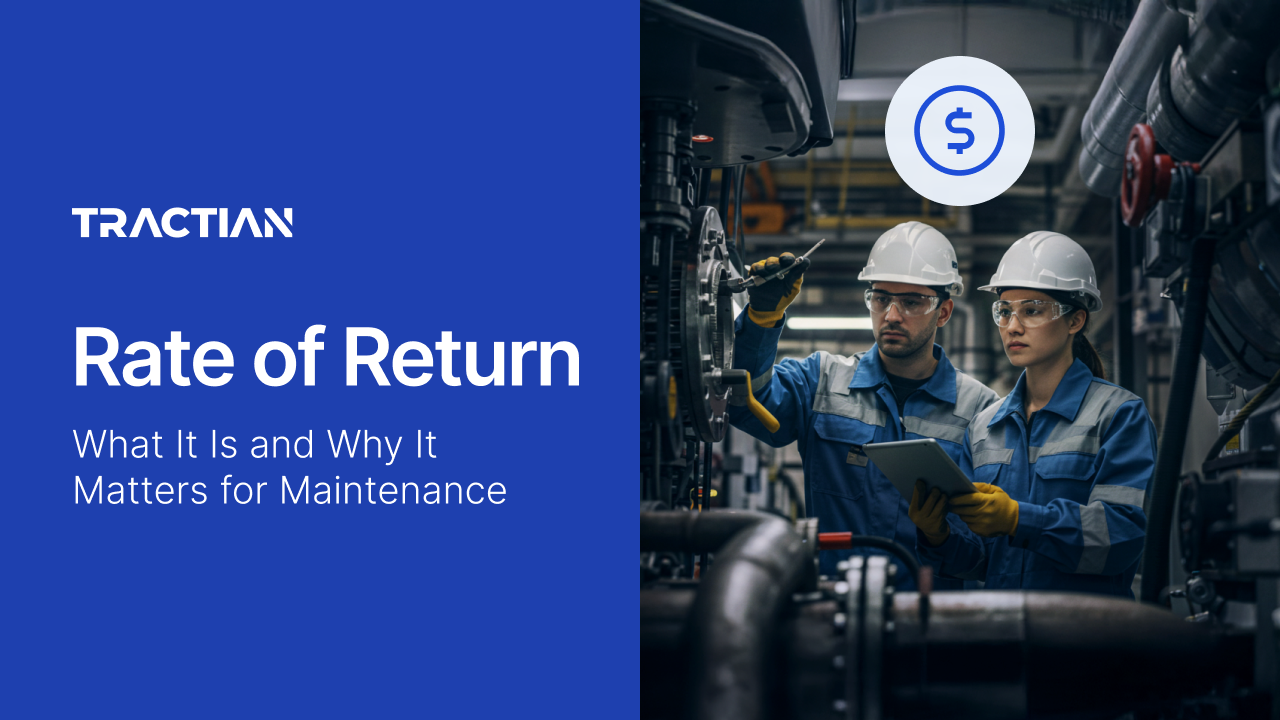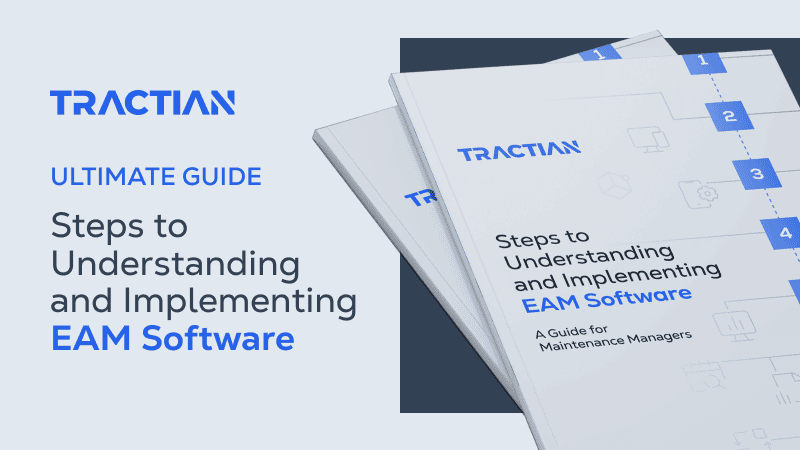Every dollar spent on maintenance should earn its keep. Yet many teams still struggle to prove that what they spend is making a difference.
It’s not that maintenance isn’t delivering value, it’s that the value often goes unmeasured. And without hard numbers to show for it, even high-performing teams end up fighting for budget, struggling to justify investments, and watching preventable failures keep slipping through the cracks.
The teams that get the resources they need aren’t always doing more, they’re just proving their worth better. And the tool that makes that possible is Rate of Return (RoR).
RoR reframes maintenance as an investment. It ties what you spend to what you avoid: unplanned downtime, emergency repairs, lost productivity. And when tracked the right way, it turns maintenance into a measurable driver of operational and financial performance.
In this guide, we’ll break down how to calculate, track, and maximize your rate of return on maintenance, so you can back every strategy with data and build a case for smarter, faster decisions.
What Is Rate of Return and Why Does It Matter for Maintenance
Rate of return (RoR) measures the percentage gain or loss on an investment compared to its initial cost. It’s a standard financial metric used to evaluate performance that can be applied just as directly to maintenance operations.
In a maintenance context, RoR helps quantify the actual impact of your decisions. It connects planned activities like preventive schedules or equipment upgrades to measurable outcomes such as reduced downtime, longer asset lifespan, and more stable production.
The principle is straightforward: maintenance should generate more value than it consumes. But RoR goes a step further by putting that value in financial terms, allowing teams to track performance over time, compare investment options, and justify resource allocation with real data.
It means more than budget tracking, it’s aligning maintenance strategy with business outcomes. And that’s why RoR can be a critical tool for both technicians and leadership.
Key Formulas and Calculations for Rate of Return
Understanding Rate of Return starts with the math. These calculations provide the structure needed to evaluate maintenance decisions and present outcomes in a way that aligns with how businesses measure performance.
Single-Period Rate of Return
The most basic formula looks like this:
RoR = ((Final Value - Initial Investment) / Initial Investment) × 100
This gives you the percentage return over a single period (typically a year)on any investment. In maintenance, this formula becomes useful when applied to initiatives like preventive maintenance programs, equipment upgrades, or process improvements.
Example:
A team invests $50,000 in a preventive maintenance initiative focused on a critical production line. Over the next 12 months, they avoid $90,000 in unplanned downtime and emergency repair costs. The RoR would be:
(($90,000 - $50,000) / $50,000) × 100 = 80%
That 80% return is more than a financial win, it’s evidence that maintenance strategy is driving real impact. When applied consistently, this kind of calculation helps teams benchmark performance and prioritize the projects that deliver the most value.
Even when upfront costs are higher, proactive strategies tend to generate better returns than reactive approaches, especially when accounting for long-term asset reliability and reduced operational risk.
Percentage Return Computation
Translating maintenance results into percentage terms makes comparisons easier, especially when you’re weighing projects of different sizes or scopes. Percentage return puts everything on the same scale, whether you're analyzing a $10,000 sensor upgrade or a $100,000 replacement plan.
This kind of normalization is key for prioritization. When multiple investments compete for a limited budget, RoR helps identify which ones deliver the highest return relative to their cost, not just which ones cost more or less.
Here are some common scenarios where percentage return gives clarity:
- Equipment replacement: Don’t just compare the upfront cost of new equipment. Factor in the ongoing expenses of keeping older assets running, like more frequent repairs, harder-to-source parts, and performance losses that impact output.
- New maintenance programs: For preventive or predictive initiatives, returns come from both avoided failures and smoother workflows. If you're reducing emergency work, streamlining scheduling, or optimizing spare parts usage, all of that counts.
- Training investments: It’s harder to quantify, but still measurable. Gains might show up in reduced rework, faster task completion, or fewer safety incidents, each one improving performance and reducing hidden costs.
By consistently applying percentage RoR, teams move away from isolated spending decisions and toward investment strategies that prioritize operational and financial efficiency.
Annual Rate of Return Method
Not every maintenance investment pays off in a single year. For projects that span multiple years, like upgrading critical infrastructure, looking at total return alone doesn’t tell the full story.
That’s why an annual rate of return can be useful. It accounts for both the size and the timing of returns, offering a year-by-year view of how your investment is performing. This makes it easier to compare longer-term maintenance projects with other business initiatives that also spread costs and benefits over time.
Say you're implementing a CMMS with an initial setup cost, recurring license fees, and expected annual savings in reduced downtime and better scheduling. Those cash flows don’t happen all at once. Some benefits kick in early, while others accumulate slowly. Annualizing the return helps you make sense of it all and compare it fairly against other capital projects.
This method brings time into the equation, helping you weigh not just how much value a project delivers, but when it delivers it. And that’s a crucial distinction when you’re planning across fiscal years or building a case for long-term investment.
Annualizing and Comparing Different Rates of Return
Once you’ve calculated returns, the next step is understanding how to compare them-especially when different investments span different timelines. Time matters. A one-year project with a high return isn’t directly comparable to a five-year investment unless you level the playing field.
Annualizing return rates allows you to compare projects on a consistent basis, even when their costs and benefits unfold over different periods. But to make truly informed decisions, you also need to distinguish between two key concepts: nominal and real returns.
Nominal vs Real Returns
Nominal return is the raw percentage gain on an investment. It’s simple and widely used, but it doesn’t reflect external factors like inflation.
On the other hand, real return adjusts for the changing value of money over time. In other words, it shows what your return is actually worth in today’s terms.
This matters most for long-term maintenance strategies. Take a program that delivers consistent savings each year. If inflation is rising, the nominal return might look steady, but the real return could be shrinking.
For maintenance leaders thinking in multi-year cycles, factoring in real return ensures that gains aren’t overstated and that investment decisions hold up against broader financial conditions.
Multi-Year Averages
When evaluating returns over multiple years, you'll need to choose between arithmetic and geometric means, each serving different analytical purposes.
Arithmetic average is the simple mean of annual returns. It works well for tracking year-to-year performance or identifying patterns over time. For example, if your maintenance improvements deliver roughly similar results each year, arithmetic averaging provides a clear snapshot of consistency.
Geometric average accounts for compounding: how each year’s return builds on the previous one. It gives a more accurate picture of cumulative growth over time, especially in scenarios where performance fluctuates or the gains are reinvested into further improvements.
If you're analyzing a multi-year reliability program, or tracking returns on equipment upgrades that scale with usage or efficiency gains, geometric averages will give you a truer long-term view. But if you’re comparing performance year by year to benchmark progress, arithmetic averages might be more practical.
Common Pitfalls and Myths in Rate of Return Calculation
Calculating RoR isn’t just about plugging numbers into a formula. The results are only as good as the assumptions behind them, and that’s where many maintenance teams slip up.
Here are some pitfalls maintenance teams may face when calculating RoR:

Ignoring Downtime Costs
It’s easy to underestimate what downtime really costs. Most calculations stop at the obvious: repair expenses or replacement parts. But that’s only a fraction of the full impact.
Teams often miss:
- Lost production: When a machine stops, output stops. That lost output often translates directly to lost revenue. And you’re still paying for labor, utilities, and overhead even when nothing’s being produced.
- Quality issues: Equipment that comes back online doesn’t always run clean right away. Scrap rates and rework tend to spike during restarts, eating into margins and wasting material.
- Customer fallout: Missed deliveries or product quality issues can affect long-term relationships, contracts, and reputation.
- Workforce inefficiency: Downtime throws off schedules. Crews get reassigned, overtime kicks in, and even after repairs, it takes time to get back into rhythm.
All of these impact your return. If they’re not in the calculation, you’re not seeing the full picture. And, as a result, you may be undervaluing the results your team is actually delivering.
Overlooking External Fees
Another common oversight is forgetting to include the full cost of getting a project off the ground.
Implementation fees, consulting hours, licensing costs: these don’t always show up in the initial budget line, but they absolutely affect your return.
When these external expenses are left out of the RoR calculation, the results can be misleading. A project might look profitable on paper, only to underperform once those hidden costs start stacking up.
That doesn’t mean these fees aren’t worth it, but they do need to be factored in from the start. The more accurate your inputs, the more reliable your return metrics are, and the better your case when it’s time to justify the spend.
Treating All Assets Equally
Not all assets should be measured the same way when it comes to rate of return. Trying to apply a single ROI standard across the board can lead to misplaced priorities.
A smarter approach looks at each asset in the context of its role, risks, and impact on operations. Here’s how that breaks down:
- Critical production assets: These are the machines that keep everything moving. If one fails, output stops and the cost is immediate. In these cases, even high-cost maintenance investments often deliver strong returns by preventing costly downtime.
- Support equipment: Think of air compressors, conveyors, or backup systems. Failures here are disruptive, but not catastrophic. The ROI expectations are different, and so is the justification for spending.
- Safety and compliance systems: Here, returns aren’t always financial. Equipment tied to worker safety, environmental controls, or regulatory compliance may not “pay back” in dollars, but the risk of non-compliance or an incident is too high to ignore.
Tailoring RoR calculations by asset type ensures that maintenance investments help align with what matters most to the business.
Boosting Your Rate of Return Through Maintenance Strategies
Improving RoR doesn’t always require big investments. It often comes down to how well maintenance is planned and executed. The most effective strategies generate measurable financial gains while keeping reliability high.
Preventive Maintenance Scheduling
One of the clearest ways to improve returns is by optimizing your preventive maintenance program. That means moving beyond fixed schedules based on manufacturer recommendations and shifting to a more data-driven approach.
Start by analyzing actual equipment performance, operating conditions, and failure trends. This helps determine more accurate maintenance intervals that reflect what’s really happening on the floor, not just what the manual says.
From there, prioritize your scheduling based on asset criticality. High-impact equipment deserves more attention, while less critical assets can follow a leaner strategy to avoid over-maintenance.
And where it’s possible, introduce condition-based triggers. These allow maintenance tasks to be performed only when necessary, based on signs of wear or performance shifts. This not only prevents unnecessary interventions but also ensures that critical issues are addressed before they escalate.
Done right, this approach reduces reactive work, improves resource allocation, and extends asset life, directly boosting your maintenance ROI.
Data-Driven Work Order Management
Strong returns don’t just come from planning the right maintenance, they also depend on executing that work efficiently. That’s where work order management makes a direct impact on ROI.
When the process is well-structured, teams make better use of their time, avoid rework, and reduce waste on unnecessary parts or labor. But to reach that level, you need more than just a tracking system, you need visibility into how work is actually getting done.
Modern maintenance platforms track each stage of the process, from the initial request to task completion. This creates a feedback loop that highlights delays, bottlenecks, and repeat failures. With that data in hand, managers can spot patterns, eliminate inefficiencies, and optimize resource allocation.
At scale, companies like Johnson Controls have seen clear operational improvements after adopting more disciplined work orders and PM scheduling processes across their facilities. That kind of structure pays off both in performance and in financial returns.
Aligning Maintenance With Long-Term Asset Goals
For maintenance to deliver meaningful returns, it can’t operate in isolation. It has to be aligned with broader business goals, particularly when it comes to asset performance, reliability, and total cost of ownership.
That alignment starts with life-cycle planning. Teams need to understand where each asset stands in its expected lifespan and whether continued investment in maintenance still makes sense. At a certain point, replacement may be more cost-effective than ongoing repairs, especially if performance starts to drop or downtime becomes more frequent.
Setting clear reliability targets is just as important. These targets should be defined by asset type and aligned with operational demands, whether that’s uptime, safety compliance, or throughput. Without those benchmarks, maintenance efforts can drift toward over-servicing or underperforming without clear direction.
And remember that capital planning needs to be coordinated with maintenance planning. When those budgets don’t communicate, it’s easy to fall into inefficient cycles like spending heavily to keep an aging asset alive when replacement is already scheduled, or worse, being caught unprepared when a critical system reaches end-of-life.
Industrial Applications and Real-World ROIs
The rate of return on maintenance investments doesn’t look the same across every industry. Operating environments, regulatory demands, and production risks all shape how value is measured-and where the biggest gains come from.
In manufacturing, ROI hinges on how well maintenance supports production. Reliability directly impacts throughput, quality, and delivery schedules, especially in high-volume operations where even small disruptions ripple across the line. Here, investment in preventive strategies often pays off quickly by protecting both output and consistency.
In food and beverage, the stakes are different. Maintenance plays a key role in compliance, and failures can mean more than downtime, they can trigger food safety risks, product recalls, and regulatory penalties. That makes traceability, documentation, and equipment condition monitoring essential not just for performance, but for operational survival.
Mining and metals operations deal with extreme conditions and high-value equipment. So when a haul truck or crusher fails, the cost of lost production adds up fast. In these environments, well-targeted maintenance investments routinely deliver high returns by preventing severe, high-impact failures.
Oil and gas operations raise the bar even further. Here, the consequences of equipment failure include safety incidents, environmental risks, and massive financial losses. That’s why reliability-centered maintenance is often non-negotiable: investments in inspections, condition monitoring, and failure prevention are justified even when the immediate financial return isn’t obvious on paper.
The context may change across sectors, but the principle stays the same: maintenance strategies must be tailored to the realities of the operation, and returns measured accordingly.
Maximize Maintenance ROI With Smarter Operations
Calculating and improving the rate of return on maintenance is a strategic shift. When maintenance is aligned with business objectives, it transforms from a cost center into a value driver, enhancing reliability, efficiency, and overall performance.
But getting there isn’t easy. It takes accurate data, consistent processes, and tools that provide clear insights. Without these, maintenance teams may struggle with reactive approaches, unclear priorities, and missed opportunities for improvement.
That’s where Tractian’s CMMS makes the difference. It gives you full visibility into maintenance operations, from asset history and costs to real-time conditions and performance trends. Work orders, inspections, inventory, and predictive insights are all in one place.
And with features like mobile access, automated task scheduling, and AI-generated procedures, teams are able to spend less time managing spreadsheets and more time getting ahead of problems.
Beyond maintenance management, Tractian's platform also enhances safety compliance and energy efficiency. By monitoring equipment conditions and energy usage, it helps organizations meet regulatory standards and reduce operational costs



